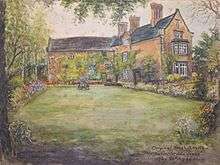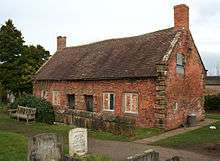Roger Wilbraham

Sir Roger Wilbraham (4 November 1553 – 31 July 1616) was a prominent English lawyer who served as Solicitor-General for Ireland under Elizabeth I and held positions at court under James I, including Master of Requests and surveyor of the Court of Wards and Liveries. He bought an estate at Dorfold in the parish of Acton, near his birthplace of Nantwich in Cheshire, and he was active in charitable works locally, including founding two sets of almshouses for impoverished men. He also founded almshouses in Monken Hadley, Middlesex.
Biography

Roger Wilbraham was born in Nantwich, Cheshire in 1553, the second of four sons of Richard Wilbraham (1525–1611/12) and his first wife, Elizabeth (d. 1589/90), daughter of Thomas Maisterson.[1] The Wilbraham family was a junior branch of the Wilbrahams of Woodhey, who were prominent in Cheshire affairs from the 13th century onwards.[2][3] His father served as Master of the Jewel House to Mary I and also collected revenues for the queen in the Nantwich Hundred.[4] In 1580, he built Townsend House on Welsh Row in Nantwich, in which James I later stayed while visiting the town in 1617.[1][2] His mother's family, the Maistersons, was one of the most important ones in Nantwich.[4]

Wilbraham became a lawyer, and was admitted to Gray's Inn in London in 1576. On 13 February 1585, he was appointed Solicitor-General for Ireland, a position he held for 14 years. During his years in Ireland, the Irish judiciary were notorious for corruption, and for bitter feuds among themselves; shortly before his arrival in Ireland Nicholas Nugent, the Chief Justice of the Irish Common Pleas, had been hanged for treason after a trial presided over by hostile colleagues. Wilbraham's attitude to judicial misconduct was cynical and pragmatic: even where a judge's conduct was disgraceful, he argued that if they gave good service to the Crown then, unless they were convicted of treason or other capital crimes, they should not be treated severely.
On 1 May 1600, he became the Master of Requests, a post he retained under James I, and he also served as the king's surveyor of the Court of Wards and Liveries. He was elected a member of parliament for Callington in 1604 and returned as knight of the shire (MP) for Cheshire in 1614.[5] He received a knighthood before 1613.[1][3][6] He kept a journal from 1593 to the end of his life.[7] He was also active in Nantwich's salt-making industry.[4]
He married Mary Baber de Tew of Somerset in January 1599/1600. The couple had three girls, Marie, Elizabeth and Catherine.[1] He purchased the Dorfold estate in the parish of Acton near Nantwich in 1602. Shortly afterwards, he gave the estate to his youngest brother, Ralph, who built the present Dorfold Hall on the site of the earlier hall in 1616–21.[1][3]
He died on 31 July 1616 at Monken Hadley, Middlesex (now in the London Borough of Barnet), of "an Ague",[1][5] an acute fever, most likely malaria. He is buried at Monken Hadley.[5] A wall monument by Nicholas Stone commemorating Wilbraham and his family was erected in the Church of St Mary the Virgin, Monken Hadley in 1616, at a cost of £80. It has busts of Wilbraham and his wife, as well as figures of their daughters.[5][8][9] His three daughters inherited an income supposed to amount to £4000 annually.[5][10]
Charitable works
In 1613, Sir Roger founded Wilbraham's Almshouses for six poor men at what was then the end of Welsh Row in Nantwich; they were the town's earliest almshouses.[11] He also founded almshouses for two poor men in Acton in the same year.[12] Additionally, he gave £4 to be distributed among the poor of Nantwich on Good Friday every year.[11] He was also active in Monken Hadley, founding almshouses for "six decayed housekeepers" in 1616.[13]
References and sources
- References
- 1 2 3 4 5 6 Hall, p. 437
- 1 2 Hall, pp. 424–26
- 1 2 3 de Figueiredo & Treuherz, p. 77
- 1 2 3 Garton, p. 52
- 1 2 3 4 5 "Wilbraham, Sir Roger (1553–1616), of St. John's Gateway, Clerkenwell, London; later of Ludgraves, Monken Hadley, Mdx", The History of Parliament: the House of Commons 1604–1629, History of Parliament Trust, retrieved 13 January 2013
- ↑ Latham, pp. 115–119
- ↑ Wilbraham, pp. 1–117
- ↑ "Parish Church of St Mary the Virgin", National Heritage List for England, English Heritage, retrieved 13 January 2013
- ↑ "Monken Hadley Church", A History of the County of Middlesex: Volume 5: Hendon, Kingsbury, Great Stanmore, Little Stanmore, Edmonton Enfield, Monken Hadley, South Mimms, Tottenham, retrieved 13 January 2013
- ↑ Wilbraham, note to p. 111
- 1 2 Hall, pp. 355, 358, 372
- ↑ Lamberton & Gray, pp. 11–12
- ↑ "Wilbraham Almshouses", National Heritage List for England, English Heritage, retrieved 13 January 2013
- Sources
- de Figueiredo P, Treuherz J. Cheshire Country Houses (Phillimore; 1988) (ISBN 0-85033-655-4)
- Garton E. Tudor Nantwich: A Study of Life in Nantwich in the Sixteenth Century (Cheshire County Council Libraries and Museums; 1983) (ISBN 0 903017 05 9)
- Hall J. A History of the Town and Parish of Nantwich, or Wich Malbank, in the County Palatine of Chester (2nd edn) (E. J. Morten; 1972) (ISBN 0-901598-24-0)
- Lamberton A, Gray R. Lost Houses in Nantwich (Landmark Publishing; 2005) (ISBN 1 84306 202 X)
- Latham FA, ed. Acton (The Local History Group; 1995) (ISBN 0 9522284 1 6)
- Wilbraham R. The journal of Sir Roger Wilbraham, solicitor-general in Ireland and master of requests, for the years 1593–1616, together with notes in another hand, for the years 1642–1649 (Scott HS, ed.) (1902)
External links
![]() Media related to Wilbraham Almshouses at Wikimedia Commons
Media related to Wilbraham Almshouses at Wikimedia Commons